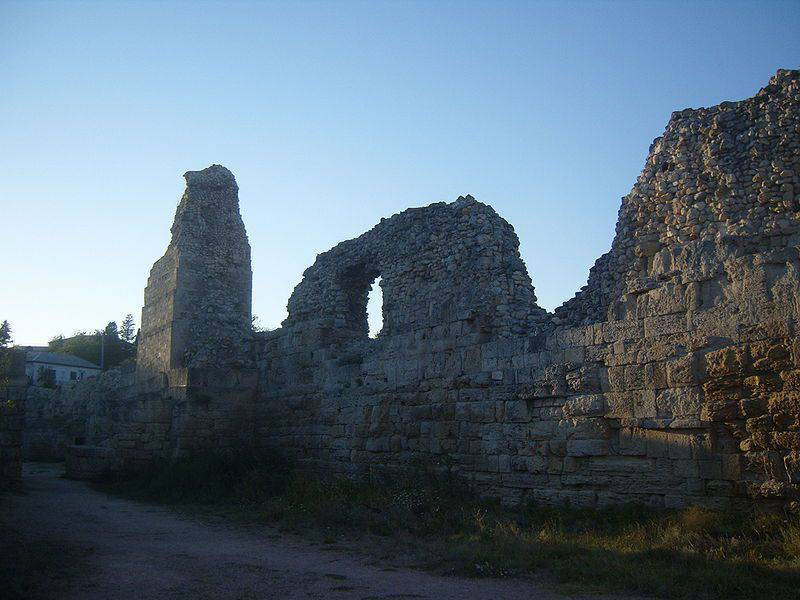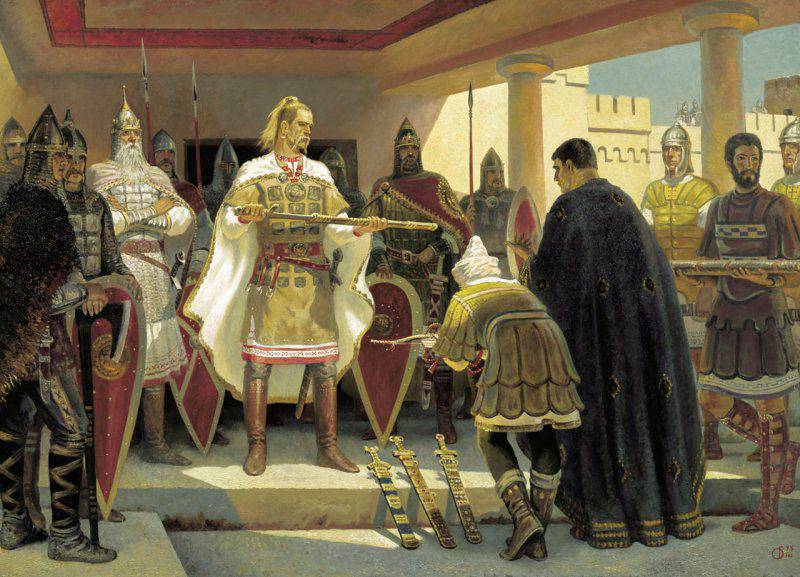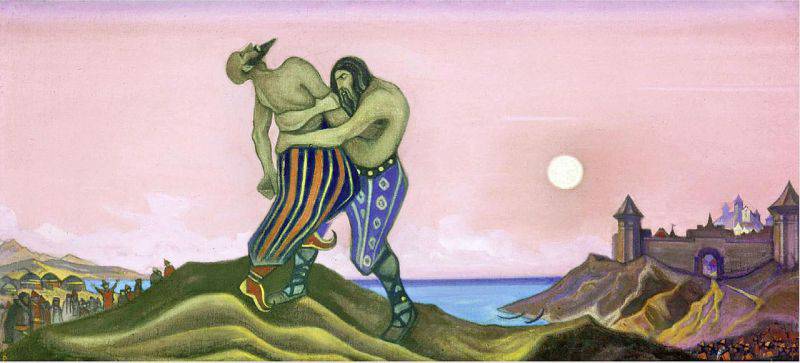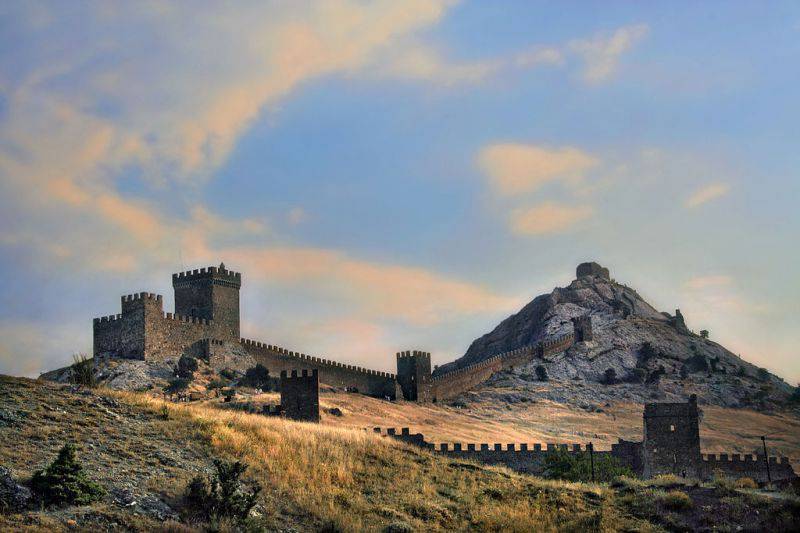Crimea: from Russian Tmutarakan to the Horde
VIII-X century - a period of Khazar influence in the Crimea. Khazaria was a very interesting public education. The Khazar tribes occupied the territory from the Caspian Sea and from the mouth of the Volga to the Don and from Ciscaucasia to the Azov Sea. The majority of the population were descendants of the same Scythians (Sarmatians and Alans), who did not share anywhere from the vast expanses of the Black Sea to the Urals and beyond. There are no traces of total genocide and replacement by another ethnic element. Some Slavic unions of tribes entered the Khazaria.
From 650, the Khazars were ruled by the Ashina dynasty, whose capital was the city Semender on the Terek River in Dagestan. Around 740, one of the Khazar military leaders - Bulan turned to Judaism. In Khazaria, a civil war occurred, which led to a change of elites. The pagan elite was defeated. The Jews occupied a dominant position, using Muslim warriors as a mercenary punitive force. The capital was Itil on the Volga. The economy of the common population was based on livestock, agriculture and fishing. And the Jewish elite of Khazaria (Jewish rakhdonite) received huge incomes due to control over transit routes going from East to West. Khazaria controlled the mouths of the Don and Volga rivers, part of the Caspian Sea, as well as the Crimea, where the Great Silk Road passed.
In addition, the rakhdonites used the Khazaria military machine for the slave trade that provided great profits. The Khazars took tribute from the people controlled by Slavic and other lands (Finno-Ugrians). The Radziwill Chronicle reports that the Khazars took "according to the white girl with smoke." And next to it in miniature, so that there was no mistake, they didn’t take it for a slip of hands, a group of girls and an elder are shown, bowing before Khazarin. Slavic children and girls were in great demand in the markets of the East. In the Khazar Kaganate rules clan slavers. Apparently, this is a shameful phenomenon for the Slavs and will become the basis for fairy tales and byli “miracle yudah the shit”, “snake”, which demanded red ladies. The historian Lev Gumilyov knowingly called the Khazaria a “chimera on the Volga”.
In the second half of the 7th century, Khazaria established control over almost all of Crimea, except for Tauric Chersonesos. Many villages were destroyed by Khazar raids. At the same time, the Khazars did not particularly interfere in the internal life of the inhabitants of the peninsula, imposing tribute and trade duties on them. City residents were left self-government. The representative of the government, Tarkhan, was located in Sudak. At the beginning of the VIII century, Khazaria and Byzantium divided the Crimea into spheres of influence: the steppe Crimea became Khazar, the Roma belonged to the southern and south-western Crimea with Chersonesos. In the middle of the 8th century, when Byzantium was experiencing a period of political instability, the Khazars attempted to seize the southern coast of Crimea. However, they met strong resistance from the local population. Byzantium retained its influence on the peninsula.
In the Byzantine part of the peninsula, the bulk of the population was represented by free rural communities, headed by councils of elders and local priests, elders. Above them were the landowners ("Timarions"), the owners of the Isar castles. The dependent peasants submitted to the local feudal lords. Even higher were the "toparchs" and "archons" - the heads of military garrisons and fortresses, representatives of the Byzantine government. Until the beginning of the XIII century, they submitted to Constantinople, but after the capture of Byzantium by the Crusaders in 1204, the power passed to the sovereign Prince Theodoro, the former archon of the Byzantine province. This small Christian principality with its capital in the city of Mangup, whose population consisted of Goths, Greeks and Alans, existed until the XV century. Theodoro was defeated by the Ottoman troops.

The ruins of the walls of Chersonese
Russian influence
In the same period, the Slavic-Russian element appears in the Crimea. According to a number of researchers whose information does not fit into the “classical” history (written by the Germans and their students), the Slavic-Russian presence on the peninsula traces from earlier times, since the time of the Sarmatian-Alanian period (Secrets of Russian history: Azov-Black Sea Russia and Varangian Russia; Part 2).
In the middle of the 8th century, the campaign of the Rus from the Don to the Crimean peninsula to Sudak itself is known. The phrase "rus" or "grew" as the name of the Eastern Slavic people were known to Byzantine and Arabic sources. At the same time, the Greeks (the Romans) associated the “Scythians” (“Tauroskifs”) with the Rus, and the “Great Scythia” with Russia. The ancient Russian state gradually began to control a significant part of the Northern Black Sea region. A tribal union of streets inhabited the land along the lower reaches of the Dnieper, the Southern Bug, the Dniester and the Black Sea coast. The Tivertsy lived between the Dniester and Prut rivers, as well as the Danube. Slavic settlements were in the Crimea. A significant number of objects of Slavic-Russian origin have been found on the peninsula. Slavic found in Korsun and southeastern part of the peninsula weapon, cult objects with inscriptions in Russian, Slavic dishes and other household items.
In the X century, the Rus and Khazars fought fiercely. The first Rurikovich (Falcon dynasty) tried to establish their control over the southern unions of the Slavic-Russian tribes, which were under the authority of the Khazars (including the fields and the Vyatichi). It was necessary to eliminate the military threat from the south and an even more dangerous conceptual "Khazar chimera" that spread the bloody slave-owning orders on the lands of Russia (Why Khazaria was for Russia a terrible enemy - "miracle Yud"; Saber kick of Svyatoslav on the Khazar "miracle-yuda"). There was also an economic prerequisite for war. Russian princes also needed control over trade routes. The historian Boris Rybakov wrote: “The struggle for the freedom and security of trade routes from Russia to the East became a common European cause. The parasitic Khazar state, which lived at the expense of customs duties, held in its hands all the exits from Eastern Europe to the East to the country of the Guz, Khorezm and the rest of the Caliphate. The Khazar Kaganate took huge duties on travel and return, and in the case of a favorable balance of power, he was simply robbed by the returning Russian caravans, as was the case in 913 year. ”
Prince Oleg Veshchy fought with the Khazars. In 939, Prince Igor of the Rus took the Khazar city of Samkerts, located on the Taman Peninsula. In 964, Svyatoslav freed a large tribal union of Vyatichi from the power of the Khazars. During the campaign 965-966. the squad of Svyatoslav with the support of the Allied Pechenegs defeated the Khazar army, took the capital of the Khazar Kaganate - Itil, seized the second city of the Khazars - Semender, located on the Terek. Then the North Caucasian tribes of the Yases and Kasogs were conquered. The hike was completed on the Taman Peninsula. Returning home, Svetoslav took an important Khazar fortress on the Don - Sarkel, renaming it to Belaya Vezha. In the same period, the Pechenegs appeared in the Crimea, they defeated a significant part of the settlements.
The results of the campaign were exceptional. The huge Khazar empire was defeated in just a year and ceased to be a threat to Russia. The Jewish Khazars fled, some settled in the Caucasus, some - in the Crimea. Paths to the East have been cleared. Sarkel and Tmutarakan - the two most important centers of the southeast, became Russian cities, forming the Tumutarakan principality.

The correlation of forces has changed in the earlier half-Byzantine, half-Khazar Crimea. Kerch (Korchev) became a Russian city. One hundred years later, Prince Gleb, Svetoslav's great-great-grandson, measured the frozen Kerch Strait and left the famous inscription on how he “measured the sea on ice from Tmutarakan to Korchev 14000 sazhen,” marking the centenary of Russian victory and domination of such important communication. Tmutarakan principality existed until the XII century, when its lands fell under the control of the Polovtsy. At this time, the Black Sea was called Russian.
Around 988-989's. Russian prince Vladimir laid siege and took by storm Chersonesus Tauride, the strategic center of Byzantium in the Crimea and the Black Sea region. He did this because the Byzantine basileus Basil II and Konstantin VIII deceived him. At one time, being in a hopeless situation because of an internal insurgency raised by the Byzantine commander Warda Fock, they asked for military assistance from Vladimir. Byzantium and Russia entered into a military alliance. Two Byzantine emperors promised Vladimir to marry his sister Anna, but did not fulfill the promise. Russian troops suppressed the rebellion, but they did not give Anna back to Vladimir. Then Vladimir took Chersonesos, declaring that this was a warning before the Russian army’s march on Constantinople. Anna was sent to Chersonese, where the wedding took place. Vladimir handed over the Chersonesos to the Romans and returned to Kiev. At the same time, he was baptized and decided to make Christianity the state religion in Russia.
During this period, the Slavs constituted a significant part of the population of the Crimean peninsula. Old Crimea, Sudak, Mangup, Chersonese - this is where the Slavs constituted the most significant part of the population. The capital of the Tmutarakan principality was located in the Taman village on the Taman Peninsula. The Russian Tmutarakan was erected on the site of the Khazar city of Tamatarkha, previously the Greek city of Hermonassa was located here, founded in the 6th century BC. er Russians, Yases, Kasogs, Goths and Polovtsy lived here. For a long time Tmutarakan was the second largest shopping center of the Black Sea, second only to Constantinople. Almost all maritime and steppe trade routes of the 11th - 12th centuries passed through Tmutarakan. At the end of the 10th century, the principality included the remnants of the restored Bosporus kingdom by Byzantium. Mstislav Vladimirovich, who ruled the principality before 1036, strengthened and expanded the boundaries of the principality. Mstislav conquered the Kasogs, killing their prince Rededu in a duel. Russian prince made trips to Shirvan. Tmutarakan firmly incorporated in the Chernigov principality.
Martial art Mstislav with Rededy. Nicholas Roerich
Thus, the claims of representatives of the Crimean Tatars that they are the indigenous population of the Crimean peninsula and therefore must have certain privileges, does not correspond to historical reality. The Slavic-Russian population lived in the Crimea since ancient times and has much more rights to be called the indigenous population of the Crimea-Tavria.
Tmutarakan was lost when the Polovtsy established control over the Northern Black Sea region. At the end of the XI century, the Polovtsy inflicted a crushing defeat on the Pechenegs. Earlier, Polovtsians lived in the basin of the Irtysh and Tobol rivers, and in the middle of the XI century they penetrated into the Dnieper and the Northern Black Sea region. They were also descendants of the Scythians, and in anthropological and cultural relations were not very different from the Rus of Kiev, Chernigov and Ryazan. The main difference was that Kiev-Novgorod Russia had already been Christianized, and the Polovtsy, like the future "Tatars", were pagans, worshiped Heavenly Father and Mother Earth. In Russia, they were called “Polovtsy” for their light hair color (in Russian polova means straw), and in the West they were called Komans or Kumans. Arabs called them Kipchaks. With the Polovtsy, the Ruses then fought, then reconciled, were friends and traded. For example, Prince Daniil Galitsky had a very good relationship with the Polovtsy, who used the Polovtsy as light cavalry during their campaigns against the Yatvyagi and Lithuania. The Polovtsy asked for support from the Russian princes when the "Tatars" invaded. Polovtsian beauties were the wives of many princes.
Russia in this period was already in decline. By the middle of the XII century, united Russia had collapsed into fifteen large state formations, which, in turn, were divided into fronts. Southern Russia, due to the constant strife of the princes, who often invited the allied Polovtsi to help, quickly lost its former significance. The ideological, political and economic center of the Russian land passed to the northeast in the basin of the Upper Volga, the former outskirts of the Russian state. Russia no longer influenced the processes occurring in the Northern Black Sea region. The Russians left the Crimea and the Black Sea region for a very long period.
Crimea, except for the Kerch Peninsula and Chersonesos, fell under the power of the Polovtsy. Their main stronghold in the Crimea was Sudak (Sugdeya). Trade in goods from Russia, Europe, the Great Steppe, Asia Minor, India and China passed through this city. It should be noted that at this time the Russians were still present in the Crimea. So, when Sudak in 1222 was attacked by Seljuks from the Rumsky Sultanate located in Asia Minor - complaints of Seljuk merchants against Sugdey, allegedly offended in the city, served as a pretext for the invasion, the combined Russian-Polovtsian army entered the battle.
The influence of Byzantium in the Crimea, after the conquest of Constantinople by the Crusaders in 1204 and the collapse of the empire, was drastically reduced. From the wreckage of the empire arose the Nicaean empire in the west of Asia Minor and the Trapezund empire in the northern part of Asia Minor, near the Black Sea. Byzantium no longer controlled the southern and southwestern Crimea. Chersonese paid tribute to Trebizond, but its power in the Crimea was nominal. Only after the re-establishment of the Byzantine Empire in 1261, Kherson again obeyed Constantinople.
In the middle of the 12th century, the principality of Theodoro (Mangup principality) appeared in the southwest of the peninsula. The principality was inhabited by descendants of the Taurians, Alans, Goths and Greeks. The boundaries of the principality passed along the Black Sea coast from Balaklava to Alushta, and in the north to the river Kachi. The capital of Theodoro was Mangup, located in the area of modern Bakhchisarai. The second major city of the Christian principality was Funa fortress. The principality had extensive international relations, including with Moscow. About 200 thousand people lived in it. Feodoro feuded with the Genoese and the Crimean Tatars. It will be destroyed by the Ottoman Turks.
Horde
In 1223, the Mongol-Tatars defeated the Polovtsy, then defeated the Russian-Polovtsian army. "Mongols" for the first time trash Sudak. The “Mongols” returned in 1239 and already arrived for a long time. Polovtsi, after a desperate resistance, were crushed. The bulk of the ordinary population joined the Horde. Part of the military elite was destroyed, some fled to Europe and Byzantium. Polovtsi, who lived in the steppe Crimea, were destroyed or subordinate, their cities and villages destroyed. Returning in 1242 from the campaign, the Mongols settled firmly in the Crimea, which became an ulus, a province of the huge Horde empire. The Crimean ulus was ruled by the viceroy of the Great Khan. Sudak retained the importance of an international port, and later Theodosia acquired the same status.
It should be noted that in the anthropological and cultural terms, the “Mongol-Tatars” had nothing to do with real Mongols-Mongoloids. These were the classic Northern Caucasians. And the descriptions of the majority of books and films where brutal persons of “Mongolian nationality” are shown do not correspond to the truth (About the strangeness of the "Tatar-Mongol" invasion; The problem of the "Mongol" invasion of Russia; Part of 2;Part of 3; Part 4). The myth of the "Mongol-Tatar" invasion was created specifically for the Vatican and the owners of the western project to hide the truth about the existence of a millennial northern civilization, known under the name of "Great Scythia", "Sarmatia", "Horde" and "Great Tartary", direct the heir of which is the Russian civilization and the superethnos of the Rus-Russians.
In the Russian Empire, this myth was officially recognized to legitimize the Romanov dynasty and the pro-Western course, the Europeanization of Russia. It was necessary to erase the memory of the Rus, to turn Russia-Russia into a cultural, raw material appendage of the European civilization. Although in reality, Europe has always been the outskirts of the great northern civilization, from where for thousands of years, there were passionate waves that led to the emergence of new cultures, states and peoples. Hence the hatred and fear of the masters of the West, the desire to solve the “Russian question” - to completely destroy and assimilate the Russians.
The Crimean governor, the ulus emir, was subordinate to the thousanders, centurions, and foremen who received land plots with a dependent population and gradually became local feudal lords. The surviving population was taxed and taxed, and at first was subjected to constant robbery, people were driven to be sold into slavery. Muslim merchants and missionaries went to the Horde through the Crimea. In 1260, a large group of Seljuk Turks migrated from the Asia Minor to the Crimea. This sharply accelerated the Islamization of the peninsula. The first mosques appear. After the Islamization of the Horde, the situation in Crimea deteriorated due to the religious press. Locals were subjected to Islamization, those who maintained their faith were legally oppressed. As a result, Islamization led to the fact that on the peninsula the remnants of the former, ancient population were destroyed. Some people were exterminated during numerous conflicts, since the Christians were the least protected, others were assimilated.
The capital of the Crimean ulus and the residence of the ulus emir became the city of Kyrym - Crimea, built by the Horde in the valley of the Churuk-Su river in the southeast of the peninsula. From the name of this city, the peninsula received the current name. Tavrika became the Crimea. The city for some time became the transit and customs center of the peninsula. From the middle of the 14th century, the Genoese Tana colony, founded at the mouth of the Don, assumed this function. In addition, on the caravan route in the eastern part of the peninsula, the city of Karasubazar is being built - the “Bazaar on the Kara-su River”, which quickly turned into the most populous and richest city of Crimea.
Genoese fortress in Sudak
To be continued ...


Information